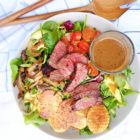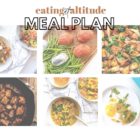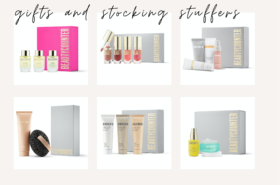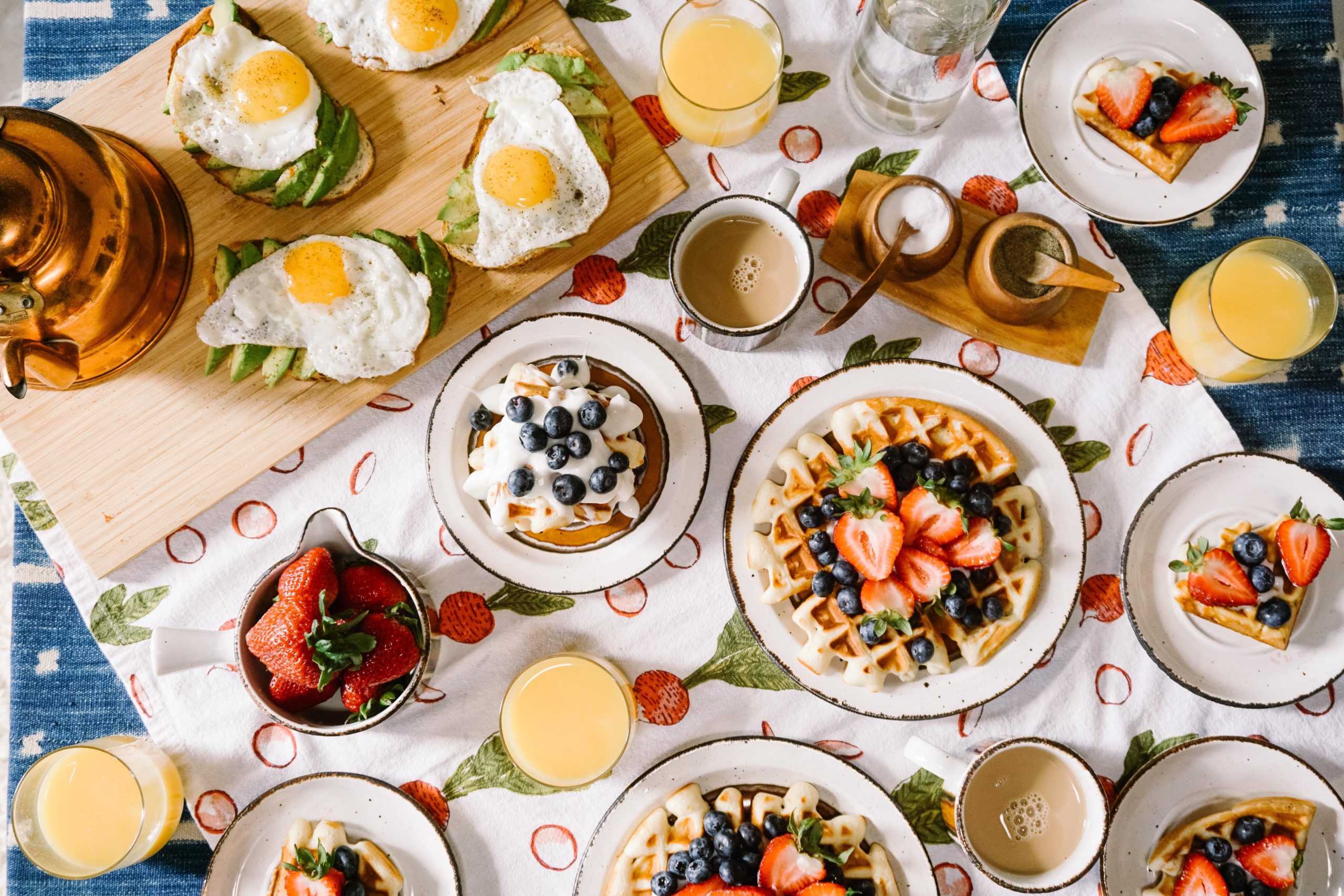If you follow me on Instagram you’ve heard me use the term Clean Eating in conjunction with my Whole30 lifestyle. At this point in time, clean eating is somewhat of a buzz word and all too often we can get caught up in the glamour of new health trends. But here is why this health trend ACTUALLY makes sense: Clean Eating is simply a way to refer to choosing a diet that consists of primarily whole, fresh & minimally processed foods. It also refers to eating eco-friendly & sustainably sourced protein & dairy products. Call it what you want: Eating Clean, eating real foods, eating better for you ingredients… .you get the point.
In Basic Terms: Eating a majority of whole/real foods and reducing consumption of processed foods.
Notice I did not say eliminate processed foods. This isn’t about perfection. I’m not here to tell you that what foods are good or what foods you should avoid entirely. This is about balance & the focus is and will always be on ADDING more nutrient – dense ingredients into your meals, and less attention on restricting other foods. I’m here to empower you & give you the basic knowledge you need to make simple changes into your existing routine to add some better for you ingredients in, as often as you are able.
Does Eating Clean mean I can never eat my favorite foods again?
Absolutely not. One reason it’s hard to maintain diets is we classify foods as good and bad, we restrict and take an all or nothing view point when approaching food. But this is about balance. We want to shift the focus from restriction and center our attention around ADDING more nutrient – dense ingredients into our meals. I’m just here to empower you by supplying you with the basic knowledge you need to make simple changes into your existing routine. Baby Steps.
Here are the basics when it comes to eating clean:
- Building Meals around vegetables and fruit.
- Eating quality protein & healthy fat foods.
- Limiting highly and ultra-processed foods.
- Making water your drink of choice.
Not All Processed Foods are created equally
Just because a food is processed doesn’t mean that it’s the worst thing for you. When eating clean we are looking for MINIMALLY processed foods. The term minimally is important here because there are whole & health foods that go through processes in order to be shelf ready & stable.
So what is processed food? “Processed food” includes food that has been cooked, canned, frozen, packaged or changed in nutritional composition with fortifying, preserving or preparing in different ways.
Processed food falls on a spectrum from minimally to heavily processed:
- Minimally processed foods — such as bagged spinach, cut vegetables and roasted nuts — often are simply pre-prepped for convenience.
- Foods processed at their peak to lock in nutritional quality and freshness include canned tomatoes, frozen fruit and vegetables, and canned tuna.
- Foods with ingredients added for flavor and texture (sweeteners, spices, oils, colors and preservatives) include jarred pasta sauce, salad dressing, yogurt and cake mixes.
- Ready-to-eat foods — such as crackers, granola and deli meat — are more heavily processed.
- The most heavily processed foods often are pre-made meals including frozen pizza and microwaveable dinners.
What Ingredients should I avoid when trying to eat less processed foods?
A rule of thumb I like to play by is only buying processed foods with ingredients I recognize. By example, if a jar of marina has tomatoes, olive oil, garlic & basil. Those are all whole food ingredients, I might have in my own pantry. I tend to pass on buying food with an ingredient list full of words I don’t recognize, words I can’t pronounce or products with an ingredient list of 15 or more ingredients.
Hidden Added Sugars: Added Sugars are in so many of the products in the marketplace. I’ll share some sugar alternatives below but the below list calls out the multiple names we see sugar show up on labels as and many of these are highly processed.
- High Fructose Corn Syrup, Dextrose, Fructose, Maltodextrin, Sucrose, Sucralose, Glucose, Monosaccharide, Glycerin, Sorbitol, Stevia, Aspartame, Acesulfame-K, Disaccharide, and many more.
Does this mean you can never buy a package of Oreos ever again because it has 50+ ingredients including multiple added sugars? Absolutely not. Remember this is about helping you understand what is in the food you put in your body. It’s okay to eat Oreo’s when you feel like eating Oreo’s.

First thing to do when you want to start eating more whole foods:
It’s really easy to get overwhelmed when wanting to move towards a healthy lifestyle. And overwhelm usually doesn’t end well. So let’s talk about baby steps. You absolutely do not need to throw everything away in your pantry that doesn’t fall into the clean eating category. As ingredients run out, let’s start to swap them with their healthier counterparts (more about that below). Taking this baby step method will make the transition less expensive & less overwhelming!
Speaking of breaking the bank. With health trends on the rise, many grocery store chains are creating generic versions of the alternatives I’m about to share. The perk of this is generic brands typically sell for less! Costco has picked up lots of whole food alternatives. Thrive Market is another resource for purchasing discounted swaps.
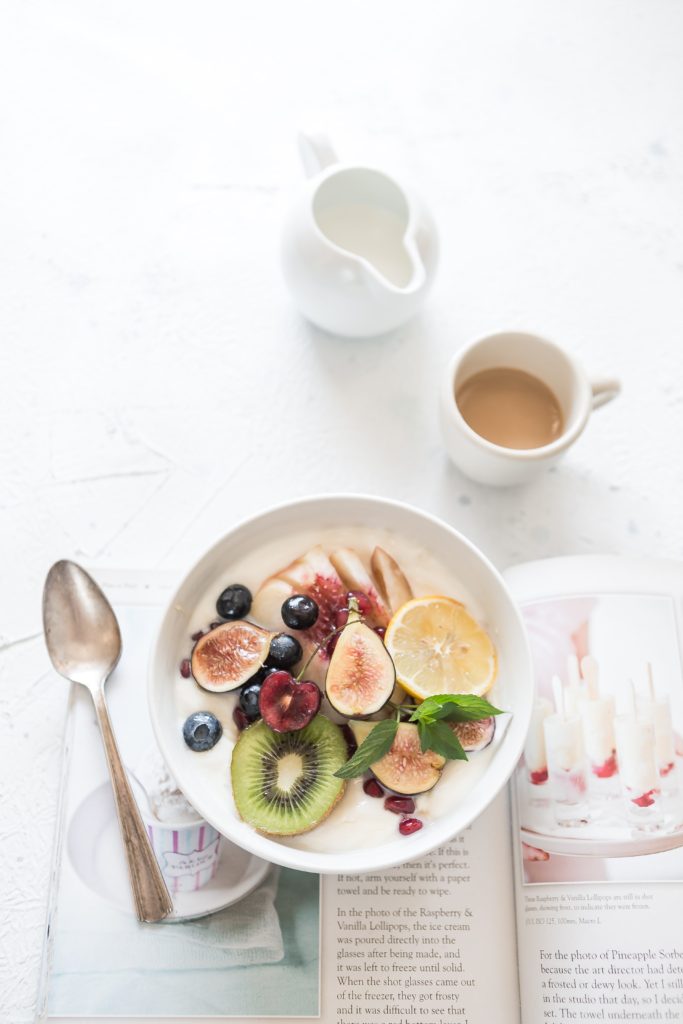
Ready to get started? Let’s Swap this for That
If you are curious how to use the swap ingredients.
White Flour:
White flour is a refined carb, it has been stripped of almost all of it’s nutrients. For this reason it’s considered as empty calories with little nutrient value. When we eat foods with low nutrient value our brain & body don’t recognize that we are full as our nutrient/ fuel tanks have not been filled. This can cause us to overeat as our body still thinks we are hungry.
Try these instead:
- Whole Wheat Flour : Unlike White flour that is striped of nutrients, whole wheat flour is actually made by grinding the wheat kernel in it’s entirety into a flour. It’s a good source of protein, fiber, and a variety of vitamins and minerals
- 1:1 Gluten Free Flour : Typically made with rice flour. This acts as a 1:1 replacement for white flour.
- Other Gluten Free Alternative Flours: Cassava Flour, Coconut Flour, Almond Flour, Oat Flour Tapioca Flour: Gluten Free Flours offer additional health benefits such as protein, fiber vitamins & minerals. The one caveat is you cannot simply switch these out 1:1 with white flour in recipes as the makeup of these flours bake and cook differently. But They can almost always be swapped out 1:1 with one another.

Sugar
Sugar, in all forms, is a simple carbohydrate that the body converts into glucose and uses for energy. But the effect on the body and your overall health depends on the type of sugar you’re eating, either natural or refined. Refined sugar comes from sugar cane or sugar beets, which are processed to extract the sugar. The outcome is the list of hidden sugars I shared above. Refined sugars are broken down quickly by our bodies, causing our blood sugar to sky rocket. Usually followed by a crash. Natural sugars are the sugars found in fruits, vegetables, dairy, and honey. They contain the nutrients natural to the plant, which makes them a better alternative.
- Maple Syrup : Maple syrup is an unexpected source of essential minerals, including calcium, zinc, magnesium and potassium
- Raw Honey : Honey contains a number of antioxidants
- Coconut Sugar: Coconut sugar retains some of the nutrients found in the coconut palm, like minerals, iron, zinc, calcium, and potassium. It also contains a fiber called inulin, which can slow glucose absorption
- Non Cooking alternatives: While you might not keep these on hand, when reading labels these more natural forms of sugar are better choices than cane sugar: Monk Fruit, Agave Nectar, Date Syrup.

Cooking Oils
Canola & vegetable (corn, soy & palm) oils are common because they are affordable. For the most part, canola oil is highly refined & goes through an extreme chemical process to be made. It is also a rich source of omega-6 fats, which is correlated to to inflammation if heavily consumed.
- Avocado oil is rich in healthy fats, enhances the absorption of important nutrients, can reduce the symptoms of arthritis, reduces cholesterol, and improves heart health.
- Olive oil is probably the best-known of the healthy alternatives to canola oil. Like avocado, it’s rich in healthy fats, plus it has large amounts of antioxidants and has strong anti-inflammatory properties. It protects against strokes and heart disease.
- Coconut oil shares many of the properties of avocado and olive oils.
- Ghee – Great alternative for Butter when cooking, more about this in the dairy section.

Dairy
Dairy: When talking about dairy this includes milks, butter, butter, cheese, yogurt and any of your other favorite dairy products.
- If choosing dairy: Organic, whole milk dairy products have more healthy omega-3 fats than conventional dairy and when you’re buying organic, you can be sure no GMOs, antibiotics, or chemical pesticides were used in their production. On top of that, cows raised on organic farms have to pasture their cows for at least 120 days a year. Grass-Fed or Pasture Raised dairy is really great. You can read more about this below in the beef section.
- Alternative Milks: Try Oat Milk, Almond, Coconut or other nut milks like cashew or macadamia these all have added nutrients. one word of advise is to read your labels and make sure your not seeing a bunch of added sugar or other additives.
- Sheep or Goats: Cows milk & sheep/goats milk stack up fairly evenly. One reason you might choose one of these alternatives is that because of it’s profile, goat & sheeps milk is easier to digest.
- Ghee: While ghee and butter share similarities from a taste persepctive, Ghee doesn’t contain lactose as the milk proteins have been removed.

Condiments & Sauces
Americans live on condiments. I’m guilty of loving a good dip, but our beloved store bought & mainstream condiments and sauces usually contain a large amount of sugar & not the natural kind. They are also commonly high in sodium & might contain other additives. But no biggie, I’ve got the swaps you’ve been looking for.
One thing to know when reading labels on any and all products at the grocery store. Ingredients are listed in descending order by weight. This means the ingredient listed first on a food label occurs in the highest quantity in the product, and the ingredient listed last is the most minimal, so keep that in mind especially when a sugar based ingredient is listed first!
- Coconut Aminos: Coconut aminos is a gluten & soy free alternative to Soy Sauce. It’s also significantly lower in sodium than Soy sauce. If going soy free is not a concern, Tamari is a gluten free alternative to Soy as well.
- Ketchup & Mustard: Mustards are usually a fairly clean condiment on it’s own, but keep an eye out for sneaky sugars in honey mustard. Most popular brands (Kraft, Hunts, etc) of ketchup contain excessive added amounts of sugar – usually high fructose corn syrup.. There are great brands in the market now that are using reduced added sugar or dates and other forms of natural sugar. these brands include: Tessemaes, Primal kitchen, Annies, & Sir Kensingtons to name a few.
For a homemade ketchup check out this recipe. - BBQ & Buffalo Sauces: Check out brands like Franks Red Hot, TesseMae’s, The New Primal, Primal Kitchen, & Thrive Market. When looking at store bought sauces, remember the rule of thumb that less ingredients are better.
For a homemade buffalo sauce check out this recipe. - Dressings & Dips: Dressing, especially our beloved ranch or other creamy dressings typically have a dairy base with other additivities. Vinaigrettes are usually made with low quality oils when buying these from the grocery store. First, I have to say that Homeade dressing are VERY easy & can last up to 7 days in the fridge. I’ll link a few below. Store bought brands to keep an eye out for: Whole30, Tessemaes, Primal Kitchen, Annies, Sir Kensigntons.
For a homemade ranch check out this recipe.
For a homemade honey mustard check out this recipe.
For a homemade creamy balsamic check out this recipe. - Queso: To eliminate dairy from your diet, check out cashew based quesos. Trader Joes has one in the refrigerated section, The Honest Brand & Siete Foods are other alternatives.
- Salsa Like most foods on this list, salsas can be full of sneaky sugars. Check your labels for basic ingredients like: tomatoes, chiles, lime juice, cilantro, garlic, salt, onions, etc.
- Pasta Sauces: The basic point is that you want to look at the ingredient list on the jar, and know each and every ingredient as something you would/could purchase separately to cook with at home. An example ingredient list might include: tomatoes, olive oil, onions, fresh basil, salt, garlic, black pepper, oregano.
A few brands I enjoy for Marinara, ingredient list may vary by flavor: Muir Glen, Whole Foods 365, Target Brand, & Thrive Market.
Pesto: traditional pesto contains cheese, so if you are okay with dairy most pestos are free of extreme additives. If you are looking for a dairy free version, Trader Joes’s Vegan Pesto is nothing but clean ingredients & freezes well!
For a homemade marinara check out this recipe.
For a homemade pesto check out this recipe.
For a homemade creamy alfredo check out this recipe - Mayo: Traditional Mayo is an oil & egg based spread. It is usually created using processed oils like canola or vegetable which leads it be being high in trans fat, deeming it “unhealthy”. With the right ingredients Mayo can actually be considered a healthy fat. Look for Mayonnaise with an avocado or olive oil base. My favorite brand is Sir Kensington Avocado Mayo.
For a homemade Mayo check out this recipe. - Nut Butters – how many times in this post will I say “sneaky sugars”? Too many, and it’s sadly because the corporate food producers add them into everything. When shopping for peanut butter, this is an item you WANT to buy organic as peanuts are one of the most heavily sprayed crops.
With peanut butter or nut butter, look for 2 ingredients or less: Nut, salt. - Spice Blends: spice blends can be found full of additives & high in sodium. If you have a full spice cabinet with single ingredient spices it’s very easy to mix up your own blends. There are also a lot of brands like Primal Palate that sell additive free spice blends.

Animal Proteins
Studies show that organic & grass fed meats & products not only encompass greater health benefits for the consumer but the label also indicates environmental benefits as well. There aren’t many times you will hear me preach about organic labeling (more about this below), but sustainably raised meats are somewhere I believe we can really do our part.
- Beef:
What to look for on the label: Organic, means the animal was raised on a certified organic pasture, and fed a diet of feed that was not sprayed with synthetic pesticides. Grass-fed, the animal ate a diet of grass only as opposed to feed. Grass fed meat is significantly higher in Omah -3s. Certified Humane: This indicates the animals were humanely raised and antibiotics were only used when the animals were sick. - Pork: Free-Range & when buying cured meats like bacon look for no sugar added or No Nitrates/Nitrates Added.
- Chicken:
What to look for: Chicken carrying the organic seal or label (regulated by USDA) mean the chicken has been fed only certified organic feed. The chicken is also free-range & and has not been given antibiotics. Pasture-Raised also means they were raised primarily outdoors.
- Eggs:
What to look for: Organic- this only refers to the organic diet hens were fed, and nothing about their living quarters, so pair organic with our next label. Pasture Raised plus a stamp that say “Certified Humane” and/or “Animal Welfare Approved,” it means that each hen was given 108 square feet of outdoor space, as well as barn space with free-reign. Here is what you can ignore: Cage-free – this simply means that the chickens were not in cages, but their living quarters are still confined in a facility with no outdoor access. Free-Range: these chickens might have access to the outdoors but it doesn’t mean they actually use it. Hormone Free & No Added Antibiotics – This label doesn’t mean much as hormones & steroids are banned by the FDA. - Fish: buy Wild Caught
Drink More Water!
Swap out sugary juices and drinks for flavored sparkling water, kombucha, or unsweetened tea.

Do I have to buy organic?
Buying and eating organic can be expensive, but on the other side of the coin it can limit your exposure to extra pesticides & toxins used by growers so trying to buy organic when your budget allows is a good idea.. Luckily, Each year the Environmental Working Group (EWG), a nonprofit organization, releases a Shopper’s Guide to Pesticides in Produce that lists fruits and vegetables with the highest and lowest pesticide residues. The produce is tested after it’s brought home from the grocery store and washed, just like you would do at home. This makes it super easy for us to prioritize when to buy organic. The below is the most recent (2021) list of foods you should buy organic.
- Strawberries
- Spinach
- Kale
- Nectarines
- Apples
- Grapes
- Peaches
- Cherries
- Pears
- Tomatoes
- Celery
- Potatoes
This post has all the information you need and more. I’d love to hear what foods you are swapping out and what steps you are taking in your kitchen or tips you can share with others on what has worked for you in transitioning to healthier alternatives. Leave a comment below or come drop me a line over on Instagram!

